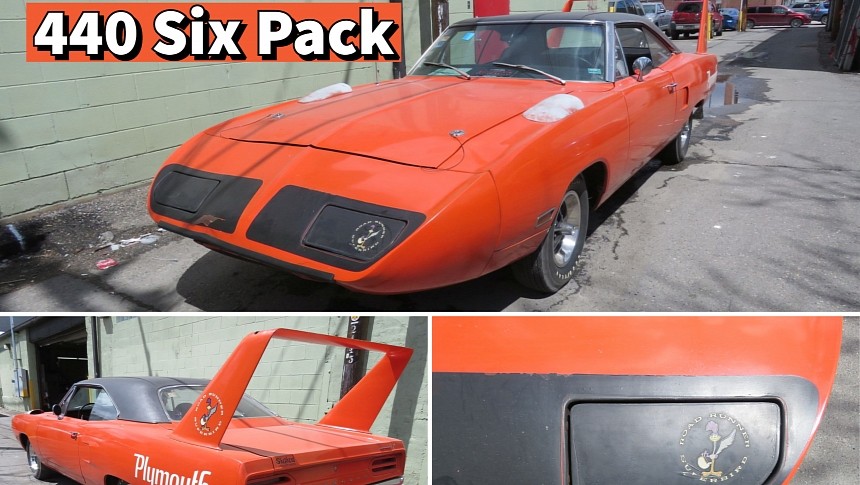In 1969, an unsuccessful NASCAR campaign with the Charger 500 prompted Dodge to develop the Daytona, the competition's first aero car. Built in just 503 units for homologation, the Daytona was followed in 1970 by an almost identical Plymouth model, the Superbird.
Based on the Roadrunner, the latter is recognizable thanks to a few different features, including a larger nose-cose grille flanked by exposed lights, closed-off fender scoops, a fuel cap hidden behind the rear license plate, and a vinyl top. More importantly, Plymouth made a lot more cars than Dodge did.
While the latter built just enough to obtain NASCAR homologation, Plymouth assembled almost 2,000 cars. Production numbers vary depending on where you look, but most experts agree that the company made 1,935 Superbirds. But that's not to say it was significantly more popular than the Charger Daytona. You see, many Superbirds sat unsold on dealer lots for several months. Some didn't find a home until 1971 or even 1972.
But the "winged warrior" that was once considered a strange-looking muscle car is now a desirable classic. It's not quite as pricey as its Daytona sibling, but well-maintained examples fetch six-figure sums. And the HEMI cars usually change hands for more than $400,000.
The Vitamin C unit you see is not one of those rare gems (Plymouth sold 135 HEMI Superbirds), but it's the next best thing regarding the drivetrain. That's because it's equipped with the 3x2-barrel version of the 440-cubic-inch (7.2-liter) Super Commando.
It was one of three engines available with the Superbird at the time and slotted between the base 440-cubic-inch four-barrel and the optional 426-cubic-inch (7.0-liter) HEMI. The mill generated 390 horsepower when new, just enough to push the Superbird across the quarter-mile strip in a little more than 14 seconds.
And while it's not as scarce as the HEMI, the 440 "Six Pack" is also hard to find. Of the 1,935 Superbirds made, only 716 left the assembly line with the beefed-up Super Commando. And needless to say, fewer than that actually made it into the 21st century.
But that's not the only thing that makes this Superbird special. It's also an unrestored survivor that got a lot of love during its life with three different owners. It still has the numbers-matching 440 V8 and the original automatic transmission, and it runs and drives as it should. It's far from perfect inside and out, but it's the kind of time capsule most of us rarely see in the metal.
It's a relatively low-mileage example, too, with the odometer showing only 57,178 miles (92,019 km). And get this: the factory chalk markings are still under the hood. Now part of the Soneff Master Garage Collection, the Superbird is waiting to change hands for the third time in its life at an auction that will take place on June 10, 2023. Do you think this unrestored survivor will break the $250,000 mark? Let me know in the comments.
While the latter built just enough to obtain NASCAR homologation, Plymouth assembled almost 2,000 cars. Production numbers vary depending on where you look, but most experts agree that the company made 1,935 Superbirds. But that's not to say it was significantly more popular than the Charger Daytona. You see, many Superbirds sat unsold on dealer lots for several months. Some didn't find a home until 1971 or even 1972.
But the "winged warrior" that was once considered a strange-looking muscle car is now a desirable classic. It's not quite as pricey as its Daytona sibling, but well-maintained examples fetch six-figure sums. And the HEMI cars usually change hands for more than $400,000.
The Vitamin C unit you see is not one of those rare gems (Plymouth sold 135 HEMI Superbirds), but it's the next best thing regarding the drivetrain. That's because it's equipped with the 3x2-barrel version of the 440-cubic-inch (7.2-liter) Super Commando.
It was one of three engines available with the Superbird at the time and slotted between the base 440-cubic-inch four-barrel and the optional 426-cubic-inch (7.0-liter) HEMI. The mill generated 390 horsepower when new, just enough to push the Superbird across the quarter-mile strip in a little more than 14 seconds.
And while it's not as scarce as the HEMI, the 440 "Six Pack" is also hard to find. Of the 1,935 Superbirds made, only 716 left the assembly line with the beefed-up Super Commando. And needless to say, fewer than that actually made it into the 21st century.
But that's not the only thing that makes this Superbird special. It's also an unrestored survivor that got a lot of love during its life with three different owners. It still has the numbers-matching 440 V8 and the original automatic transmission, and it runs and drives as it should. It's far from perfect inside and out, but it's the kind of time capsule most of us rarely see in the metal.
It's a relatively low-mileage example, too, with the odometer showing only 57,178 miles (92,019 km). And get this: the factory chalk markings are still under the hood. Now part of the Soneff Master Garage Collection, the Superbird is waiting to change hands for the third time in its life at an auction that will take place on June 10, 2023. Do you think this unrestored survivor will break the $250,000 mark? Let me know in the comments.





















